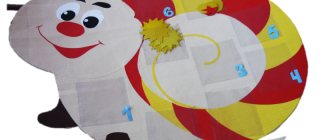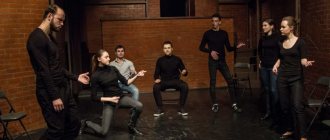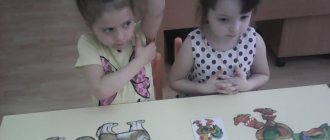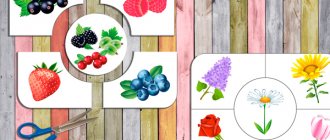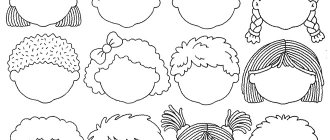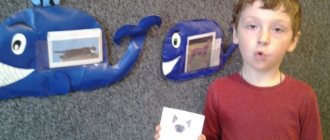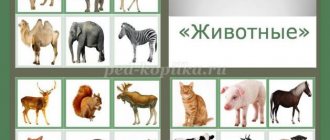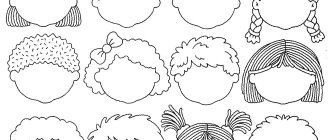Article:
Goal: to introduce parents to didactic games aimed at the formation and development of mobility of the articulatory apparatus, breathing, phonemic hearing and lexico-grammatical structure of speech.
Establishing contact between participants. Creating a friendly atmosphere. Tasks:
1. To convey to parents the importance of developing the mobility of the articulatory apparatus and breathing in children with general speech underdevelopment.
2. To help parents that didactic games develop phonemic awareness and prevent the occurrence of dysgraphic errors when learning to read and write, and contribute to the intensive development of the skill of reading whole words.
3. Show in practice how in a playful way you can consolidate children’s knowledge of the development of phonemic awareness, grammatical structure of speech, and coherent speech.
Logosharik doll , mirrors, background music, sea pebbles (dark and light, laces, pasta, wooden beads, pictures with words of different syllabic structures , cards with diagrams of the place of sound in a word; red, blue and green circles, ball.
Progress of the event.
Speech therapist : Hello, dear parents !
Imagine that today you are not serious, authoritative adults, but children of 5-6 years old. What did you want most as a child? Probably play! And it is right. After all, the leading activity for preschool children is play.
When playing, children are, first of all, captivated by the action of the game, it stimulates children's activity and evokes a feeling of satisfaction. Unnoticed by himself, without much tension, while playing, the child performs a didactic task. The didactic game also has a certain result, which is the finale of the game , where the achievements of each child are emphasized, and for the teacher the result is an indicator of the children’s success, the acquisition of knowledge and skills.
So you and I are going to play now. Unusual games - speech therapy . These games not only entertain, they help develop speech.
Speech therapist : To speak well, you need to train your articulatory apparatus. Logosharik will tell us what an articulatory apparatus is .
(The doll shows lips, teeth, tongue, upper and lower palate).
Articulation gymnastics:
1. “The frogs are smiling” (After counting the shells in the pond, the frogs smile. One, two, three, four, five - start counting too.)
2. “Trunk” (The elephant pulls its trunk up, he wants to get a nut. One, two, three, four, five - we must try again.)
3. “Hippopotamus” (The hippopotamus opened his mouth, the hippopotamus wants porridge. Feed the baby, he needs three buckets. One, two, three. The hippopotamus closed his mouth, the hippopotamus ate the porridge.)
4. “Robot” (The robot stretched in the morning, he smiled from ear to ear. He didn’t have time to lubricate it with grease and his smile became rusty)
5. “Horse” (A white horse gallops along a flat, smooth path. Clack, clatter, clatter - the hooves are knocking, the horse is racing far.)
6. “Cup” (Mom pours tea, quickly replace the cup. To prevent the tea from spilling, the tongue rises up.)
Breathing exercises.
To pronounce sounds correctly, you need a strong air stream. Children really like games to develop a long and strong air stream. Try it too.
Different tasks for three groups. (Blow into a tube onto a ball in the water. Draw geometric shapes with air felt-tip pens. Blow on the pinwheels).
Be sure to make sure that your cheeks do not puff up when exhaling.
Phonemic games .
In order for a child to pronounce sounds correctly, he must learn to hear them correctly. Not just to hear correctly, but to distinguish, analyze and differentiate sounds. This skill is called phonemic awareness.
A small child does not know how to control his hearing and cannot compare sounds. But a child can be taught this. It is especially necessary to develop auditory attention and phonemic hearing for children with speech problems. Sometimes a child simply does not notice that he is pronouncing sounds incorrectly.
The purpose of phonemic games is to teach the child to listen and hear. By regularly playing with your child, you will notice that the child has begun to hear himself, his speech, that he is trying to find the correct articulation of sound and correct defective pronunciation.
In the initial stages, we learned to listen to the sounds of the world around us. Game “Listen to the silence”, “What does it sound like?” and others. Today we will play with speech sounds.
1. “Catch the Sound”
Target. Development of phonemic hearing, the ability to isolate a given sound from a number of sounds, syllables , in words.
Speech therapy board-print game “Pictures with a secret”
All-Russian competition of pedagogical excellence
for the best printed board game
Speech therapy board game
"Pictures with a Secret"
Author of the game:
teacher-speech therapist Tikhomirova Ekaterina Vitalievna
“The game is not empty fun.
It is necessary for the happiness of children, for their health and proper development.”
D.V. Mendzheritskaya
The specifics of the work of a modern speech therapist teacher are such that it is necessary to provide assistance to a large number of children, accelerating the correction process in various ways. The urgent task for the teacher is to search for new teaching technologies that allow speech therapy to be carried out most effectively.
The greatest effectiveness of correctional classes is achieved when using such gaming technologies, which contribute not only to the correction of impaired speech components, but at the same time develop fine motor skills, improve all cognitive processes and, of course, make speech therapy classes interesting and exciting.
At this time, store shelves are replete with a large selection of speech therapy games and aids. But they are not always affordable, and speech therapy rooms, as a rule, are not large enough to accommodate large-sized benefits. Therefore, I prefer to use multifunctional aids in my work that do not require much storage space. I present to your attention one of these benefits: the speech therapy board and printed game “Pictures with a Secret.”
This game is easy to make and use. It consists of six playing fields, A4 format and fifty small square chips. The playing fields and chips are printed on thick cardboard. To increase the service life and the possibility of sanitization, they should be laminated. Best stored in a large plastic envelope.
The speech therapy board game “Pictures with a Secret” is intended for individual and subgroup speech therapy sessions with children aged 5-8 years.
Purpose of the game: to form clear, grammatically correct speech as a means of communication.
Tasks:
enrichment of the active vocabulary;
automation and differentiation of sounds [S, Z, Sh, Zh, L, R];
formation of grammatically correct speech;
development of phonemic hearing;
the formation of sound analytical-synthetic activity as a prerequisite for learning to read and write;
improvement of mental processes;
improving fine motor skills.
For the game, we select the playing field in accordance with what sound we need to automate with a particular child. And we offer him a series of tasks one by one. Tasks can vary depending on the situation, taking into account the interests and speech abilities of the child.
Options for tasks using the example of a playing field for sound automation [C]:
When first getting acquainted with the playing field, we invite the child to carefully examine and name all the pictures correctly, pronouncing the sound [S] ([S, Z, W, F, L, R]).
The second version of this task using chips. The child names the pictures; if the automated sound is correct, he covers the picture with a chip.
You can use multi-colored chips, and then we complicate the task. Having covered all the pictures with chips, the child must guess what is behind which chip. The speech therapist asks the preschooler to name all the pictures that are under the blue (red, green) chips.
Game task “Finders”. Name what is in the upper right corner (lower left, etc.), what is between the apricots and coconuts, what is in front of the boots, who is after the juice, above the pineapple, under the elephant, etc.; The second option is more complicated; the child must tell himself where this or that object is located.
Game task “Who? What?". Cover all items that answer the question “Who?” The chips are blue, and the green chips are items that answer the question “What?”
Name inanimate objects in the plural. For example: apricots, soups, coconuts, sleds, etc. etc..
Call all living objects affectionately. For example: owl, elephant, fox, etc.
Name all the animals you see (fruits, shoes, food).
Name in one word: owl, elephant, badger, fox. Same with other lexical categories.
Game task “Guess the object from the description.” Children are asked to guess the item from the description. For example, a speech therapist lists the signs: healthy, orange, sweet... (orange juice) or rubbery, smooth, yellow... (boots). The second option is more complicated, when one child guesses the object, and the others guess.
Game task “What is what?” The speech therapist asks: rubber boots made of what?, leather sandals made of what?, orange juice made of what? Etc. The second option is more complicated, when the child himself must form an adjective from a noun. The speech therapist asks: “Rubber boots, what are they?” and the child must form the word “rubber”, etc.
Game task “Greedy”. Guys, do you know who is called greedy? A greedy person is someone who doesn’t know how to share, who takes away what belongs to others, and who always doesn’t have enough. And although there are no greedy people among us, now we will play the game “Greedy”. You need to choose the right words my, mine, mine, mine for our pictures and cover them with the corresponding chip card. The winner is the one who completes the task faster and does not make mistakes. The speech therapist determines which of the children will cover which pictures: Masha selects pictures for the word “mine”, Misha for the word “mine”, Lena for the word “mine”, Vasya for the word “mine”. After the children have completed the task, we check the correctness, once again talking through all the options.
Game task “Where is the sound hidden?” In an individual lesson, you can ask your child to find and cover with chips all the pictures whose names have the sound [C] at the beginning (middle, end). And in a subgroup lesson, you can distribute tasks among the children: Masha selects pictures with the sound [S] at the beginning of the word, Misha with the sound [S] in the middle of the word, and Lena with the sound [S] at the end of the word. After the children have completed the task, we check the correctness of execution and once again pronounce all the words correctly pronouncing the sound [C]. A mutual review can be arranged.
You can ask your child to remember as many pictures as possible, then turn the game board over and ask the preschooler to list the pictures that he remembers.
Game task “What’s missing?” The speech therapist covers any picture with a chip with a question mark and asks the children to guess what is missing. Then you can complicate the tasks by covering not one, but 2-3 pictures.
These same task options can also be used when working with playing fields for other problematic sounds.
Children love the fact that they can play different tasks with the same playing field. And every time they come to class, they wonder what the new task will be. And the process of automating difficult sounds is more fun and relaxed.
For download. PDF / 1.1 MB
Games and exercises
Game “Greedy” (children 4-8 years old)
To the name of each vegetable we add the word “my”, “mine”, “mine” (my carrots, my cucumber)
Game “One - Many” (children 4-8 years old)
. Up to 5 years, the version of the game is shortened (without a lot of words). Tomato - tomatoes - a lot of tomatoes potatoes - potatoes - a lot of potatoes (potatoes) eggplant - eggplants - a lot of eggplants pepper - peppers - a lot of peppers zucchini - zucchini - a lot of zucchini pumpkin - pumpkins - a lot of pumpkins carrots - carrots - a lot of carrots beets - beets - a lot beets (beets - meaning “many pieces”) onion (bulb) - onion (bulbs) - a lot of onions (bulbs) turnip - turnips - a lot of turnips radish - radishes - a lot of radishes (radish - meaning "many pieces") garlic - garlic - a lot of garlic (many heads of garlic) parsley - parsley - a lot of parsley cucumber - cucumbers - a lot of cucumbers pepper - peppers - a lot of peppers (meaning “many pieces”) head of cabbage - heads of cabbage - many heads of cabbage pea - peas - many peas pod - pods - a lot of pods
Exercise “Call it kindly” (children over 4 years old)
Cucumber - cucumber - cucumbers tomato - tomato - tomatoes potatoes - potatoes - potatoes eggplant - eggplant - eggplants pepper - pepper - peppers pumpkin - pumpkin (pumpkin) - pumpkins radish - radishes - radishes carrots - carrots (carrots) - carrots beets - beets ( beetroot) - beetroot onion (onion) - onion (onion) - turnip bulbs - turnip (turnip) - turnips garlic - garlic - garlic parsley - parsley - parsley dill - dill - dill cabbage - cabbage - cabbage beans - beans - beans
Game “Say the other way around” (children from 5 years old)
The zucchini is large, and the cucumber is a small potato, large, and the radish is ... (small), the pepper is empty inside, and the carrot is ... (full), the tomato is soft, and the cucumber is ... (hard)
Game “Say the other way around” (children from 6 years old)
A good garden bed -……. bad bed Old potatoes - ...... new potatoes Heavy bag - ...... light bag Large harvest - ………. small harvest Clean carrot - ……… dirty carrot Ripe tomato - ...... unripe tomato
Exercise “Complete the sentence” (children from 5 years old)
The tomato is round, and the carrot... (oblong). The tomato is red, and the carrot... The tomato is soft, and the carrot... The tomato is sour, and the carrot... The tomato has seeds inside, and the carrot... The tomato grows on the ground, and the carrot... (in the ground).
Game “Names of juices” (children from 5 years old)
Cucumber juice - cucumber juice Beet juice - beet juice Onion juice - onion juice Tomato juice - tomato juice Cabbage juice - cabbage juice Pumpkin juice - pumpkin juice Carrot juice - carrot juice
.We strengthen the ability to coordinate nouns and adjectives denoting color, shape, size, taste.
Development of auditory attention
. Corrected sentences must be spoken in their entirety. Let's make mashed potatoes from carrots. Let's prepare beetroot salad from garlic. Let's make carrot juice from onions. Let's make cabbage pie from zucchini. Let's make cucumber salad from tomatoes. Let's make pea soup from radishes. Let's make pumpkin jam from dill.
Game “Count” (for children from 5 years old)
1 tomato - 2 tomatoes - 5 tomatoes 1 cucumber - 2 cucumbers - 5 cucumbers 1 zucchini - 2 zucchini - 5 zucchini 1 pepper - 2 peppers - 5 peppers 1 beet - 2 beets - 5 beets 1 head of cabbage - 2 heads of cabbage - 5 heads cabbage 1 head of garlic - 2 heads of garlic - 5 heads of garlic 1 clove of garlic - 2 cloves of garlic - 5 cloves of garlic 1 pea pod - 2 pea pods - 5 pea pods 1 pea - 2 peas - 5 peas
At 6-7 years old, you can complicate this exercise by adding a suitable adjective to the noun.
One crispy cucumber, two crispy cucumbers, etc.
“Harvest” (children from 6 years old)
An adult shows pictures of vegetables and asks the child to answer the question: “How is this vegetable harvested?” The child makes sentences - for example: cabbage is cut, etc. Carrots, beets, turnips, radishes - ... (pull) Cucumbers, tomatoes, peas - ... (pluck) Cabbage - ... (cut) Potatoes - ... (dig up)
Classification of concepts “Which words are superfluous and why?”
Onions, turnips, plantain, lettuce (plantain is not a vegetable, but a herb); garlic, radishes, beets, currants, zucchini, strawberries, cucumbers, chamomile potatoes, peppers, eggplant, pumpkin
Game “Guess the vegetable by its part”
. Head – Tops – Pod – Root – Slice – Stem – Ear – Clove – Tuber – Bunch –
Game "Who can name the most qualities"
. Goal: agreement of nouns and adjectives denoting color, shape, size, taste. Color - red, orange, green... Taste - sour, sweet, bitter... Shape - round, oval, triangular... Surface - smooth, rough, uneven... Tomato (which?) red, round, juicy, sweet, soft... Beet (which ?) burgundy, round, juicy, sweet, firm...
Progress of the lesson:
Greetings
Hello guys, it's great that you all came today!
Our smart heads will think a lot, cleverly. The ears will listen, the mouth will speak clearly. Hands will clap, Feet will stomp. Our backs straighten, we smile at each other
Surprise moment “Wonderful bag”
Here is my bag. Not simple, but wonderful. Put your hand into it and take out something.
Game "Feed the Bunnies"
Take your vegetables, put them on a plate and feed the bunnies.
Didactic game “What did the bunny eat?”
Here the bunny has cabbage, cucumber and carrots. (The carrot is hiding). What did the bunny eat? The bunny ate a carrot. What's left? All that's left is cabbage and cucumber. What color is cabbage? Green. What color is the cucumber? Green.
Button game “Vegetables in a jar”
Arrange the buttons into circles of the appropriate color and size.
Drawing "Salad"
Look, this picture shows everything you need for a vegetable salad - a salad of vegetables: tomato, cucumber, pepper, onion, salt, oil. And at the bottom of the sheet there is a salad plate - a salad bowl. Take a pencil in your hands and draw lines from each product to the salad bowl.
Didactic game “Plant a vegetable garden”
There are many beds in the garden. There are carrots and lettuce. There are cucumbers and peas here. Are potatoes bad? Our green garden will feed us all year round.
Roll the salt dough into a thick sausage - this will be the bed. Stick carrots into the dough - we will have a bed of carrots.
Drawing “Grow up, carrot”
On a prepared background, children draw horizontal stripes on carrots with a brown pencil.
Exercise “The carrot has grown”
(Done together with parents).
First, they planted a small seed in the ground. (Children squat down)
The sun warmed the cabbage, the rain poured down and the carrots began to grow. (Children slowly get to their feet)
The carrots have grown green leaves. (Raise your hands up)
It's time to pick the carrots. (Parents hug their children and pick them up - they pick carrots from the garden)
Finger game "Vegetables"
The girl Arinochka has vegetables in her basket. (Fold your palms into a “basket”)
Here is a pot-bellied zucchini I placed on a barrel, Pepper and carrots I placed deftly. Tomato and cucumber. (Bend your fingers, starting with the thumb)
Well done Arina. (Show thumb)
Didactic exercise “One-many”
The teacher puts a picture of a vegetable on the magnetic board, and distributes the remaining pictures to the children one at a time.
I have one vegetable. And how much do you have? Anya has one carrot. Denis has one cucumber. Place your vegetables next to mine on the board. How many vegetables are there? A lot of.
Vocabulary work “One-many”
The teacher picks up a vegetable and names it in the singular, then hands it to the child and asks him to name the plural. One carrot, but how can you tell if there are many of them? Lots of... carrots.
One cucumber - many... cucumbers. One tomato - many... tomatoes. One pepper - many... peppers. One potato is a lot of... potatoes. One cabbage is a lot of... cabbage.
Application “Canning vegetables”
Place a large and a small cucumber, a large and a small tomato on top of the jar image. Arrange the vegetables so that they all fit into the jar. Now stick the vegetables onto the jar.
Dynamic pause “Gardeners”
We took the shovels (movements depicting the toe of a shovel on the shoulder)
The beds were dug up. One-two, one-two - That's how they dug it up
They took the rake in hand and combed the beds. One-two, one-two - That's how they combed it. We planted seeds in rows in the ground. One-two, one-two - This is how we planted (movements in accordance with the text)
We watered the beds with cool water. One-two, one-two - This is how they watered (depict watering the beds with a watering can)
The harvest was rich and they gathered together. One-two, one-two - This is how they assembled (tilts)
We started the dances and songs ourselves. One-two, one-two - That’s how they started it. (claps hands)
Exercise "Cooks"
And now you will be cooks, take knives and cut the fruit into pieces. Using plastic knives, children “cut” vegetables into halves (secured with Velcro). — How many pieces did you cut your vegetable into? Let's count: one, two. You cut it into two halves.
Finger painting “Methodius the goat’s vegetable garden”
Show the goat Methodius in the picture. Name what vegetables grow in his garden? Cabbage, carrots, tomato. Now we will color these vegetables. What color should we color the cabbage? Green. What color should we paint the tomato? In red. What color should we paint the carrots? Orange color.
Exercise “Move the peas”
The bunny is hungry again. Let's feed him peas. Spoon the peas from the pan and transfer them to a plate.
Modeling "Pea Pod"
Children make a sausage out of green plasticine and press peas into it.
Finger gymnastics “Salting cabbage”
We chop and chop cabbage. Movements with straight palms We three, three carrots, rub our palms together We salt the cabbage, salt it. Place your fingers into a pinch. We press and press cabbage. Clench and unclench your fists.
Demonstration of the tabletop theater "Methodius the Goat"
Who's wandering around in the garden? - It’s me, the goat Methodius. - For what kind of business? — I help the guards. I protect the cabbage, I protect every leaf... - Why suddenly cabbage, and not radishes and not onions? How can this be, tell me, Methodius?! You forgot about them, it turns out! - I haven’t forgotten anything, But I don’t have enough strength for everything. I don’t know how to preserve onions, but radishes make me lose weight. And cabbage is good, And it needs guards, Because the most delicious, Very tasty - Cabbage leaf!
Vocabulary work “Big and small”
Cucumber is a cucumber. Potato - potato. Cabbage is cabbage. Tomato is a tomato. Onion - onion. Garlic is garlic. Carrot is a carrot. Beetroot - beetroot.
